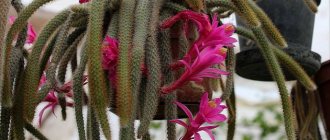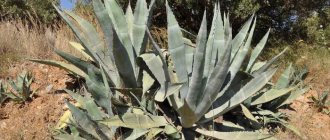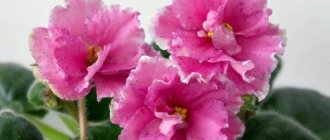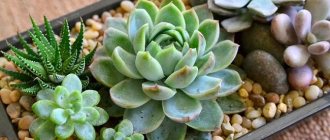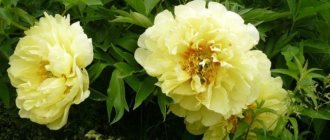The succulent plant Lithops, popularly called “living stone,” is a member of the Aizaceae family. In nature, it prefers to grow on limestone, granite and rocky dehydrated soil. This exotic plant has a very unusual appearance: it has only a couple of massive leaf plates, the height and width of which do not exceed 50 mm.
Lithops foliage looks very similar to small pebbles. During the flowering period, which occurs from late August to mid-October, a peduncle forms between these leaves, after which the flower opens. When the bush fades, a seed fruit is formed, the opening of which is observed when it rains. This perennial plant comes from the southern regions of South Africa, more precisely, from the deserts of Botswana and Namibia.
The petals of the flowers are similar in appearance to chamomile. Most often, fragrant flowers are yellow or white. The bush is characterized by extremely slow growth. Over ten years of life, it reaches a size of about 50 mm, while its life expectancy is a maximum of 15 years. Lithops is undemanding to care and growing conditions. It is perfect for all gardeners, even beginners.
Description
Lithops belongs to the Aizaceae family. They are divided into types and subspecies according to size, color and colors. Although it can be difficult to determine whether they belong to a specific species. Lithops can change color to adapt to their environment. Botanists have identified 37 types of “living stones,” but about ten popular species are grown at home.
This is what Lithops looks like in its natural habitat
The rocky desert of South Africa is considered the birthplace of Lithops. They are also found in the Southwestern part of the African continent. Rocky slopes covered with granite chips, areas with clay soil - this is where you can find “living stones”. Sometimes they blend in color with the surrounding stones, hiding half among the stone scatterings from the heat.
Lithops have good survival rate. They grow even where there are no other plants. During the day they can withstand fifty-degree heat, followed by cold nights. After all, in deserts there is a big difference between day and night temperatures.
Lithops structure
Externally similar to pebbles, the plants consist of pairs of fleshy leaves that do not have a stem. They are attached to the root, merging at the base. Thick leaves store moisture to survive dry periods. The leaves are separated by a hollow slit, in which light green meristem cells are visible. Flowers and new leaves emerge from it. The leaves themselves have a gray-green, purple or brown tint on the side. And from above you can see lighter leaf windows through which the plant exchanges gases and receives sunlight. Under natural conditions, only the upper part of the plant with leaf windows is visible among the stones and sand.
Important! Lithops tissues contain toxic substances that can be harmful if ingested by children and pets.
Flowers appear from the hollow, and their diameter exceeds the size of the leaves. The flowers are usually white or yellow. In this case, the yellow color varies from bright yellow to light yellow.
Lithops are perennial plants, but they annually replace old leaves with new ones.
Main varieties of “living stones” Lithops
We propose to dwell on the most popular species of the Lithops genus and their characteristics:
Lithops aucampiae or L. Aucamp
A South African variety, which has two thick, fleshy leaves, colored brown or brown, but bluish shades can also be found.
Lithops aucampiae
The leaves are separated by a crack, from which the original yellow flower appears over time. In volume it reaches up to 4 centimeters.
L. bromfieldii or L. Bromfield
A succulent succulent that also comes from Southern Africa. Without flowering, it visually looks like a marble stone in yellow-brownish or reddish tones.
L. bromfieldii
In autumn it can delight you with its original blooms of green, white or red. Some varieties may bloom with white buds.
Lithops comptonii or L. Compton
The main difference between this variety is the original flowers, painted in several shades.
Lithops comptonii
The center is white, and the ends of the petals are deep yellow. Prefers well-drained soils.
L. dorotheae or L. dorotheae
A miniature variety that reaches a height of 1 centimeter.
Lithops dorotheae
The leaves of the succulent visually resemble the fine-grained quartz where the crop usually grows. You can only spot this exotic species by its rich yellow flowers.
Lithops francisci or L. Franz
A popular species native to Namibia. Visually, such plants look like small pebbles, so they are perfectly camouflaged in the desert.
Photo of Lithops francisci
The leaves have a soft pink color, maybe cream or beige. There are specks or streaks on top of them. The flowers are small, visually rich yellow.
Lithops karasmontana or Lithops Karassky
It is distinguished by fleshy gray-brown leaves of a hemispherical shape.
Lithops karasmontana
Flowers are formed from the middle of the leaves. The buds are white.
Lithops fulviceps or Lithops Redhead
It is endangered, an extremely rare and valuable species.
Lithops fulviceps
The leaves are greenish-brown in color and cylindrical in shape with characteristic patterns. In nature it blooms with yellow buds. Certain varieties are snow-white.
Lithops optica
Native to Namibia, visually similar to an eyeball.
Photo by Lithops optica
The leaves have a cherry tint. Some varieties are distinguished by their purple color. White flowers
Varieties
If about forty species grow in natural conditions, then in indoor floriculture a dozen to one and a half popular species and hybrids are grown. Let's look at the most famous varieties of “living stones”.
Aucamp
The leaves have a rounded upper part, reaching four centimeters in width. The main color is green, but there are varieties of gray-blue color. And there are brown spots scattered on the top. The gap between the leaves is deep. The flowers are large and yellow.
Leslie
It is distinguished by its small size - the diameter of the upper part is from 1 to 2 cm. Colors: gray; brown with a pink tint; coffee with milk; reddish green. The upper part is covered with marble stains of a darker color. The size of the flowers exceeds the diameter of the leaves, reaching five centimeters. Yellow or white flowers emit a light scent.
Most suitable for beginner gardeners, as it tolerates errors in watering more easily than other types.
Marble
The gray leaves expand upward, reaching two centimeters in diameter. The upper part is covered with a marble pattern, which gives the species its name. Flowers are white, 5 cm in diameter.
Olive green
The olive green color of the leaves at the top is complemented by spots. Plant dimensions: height – 2 cm, width – 1.5-2 cm. It is distinguished by a small depth of the gap between the leaves, not exceeding 5 mm. Flowers are yellow.
This may be interesting: Stapelia - home care
Optics
The leaf size is 2 cm. The color of the leaves ranges from light green to gray-green. There is a subspecies with purple leaves. The leaves are separated by a deep cleft. Flowers are white.
Beautiful
Size: height - up to 3 cm, and diameter - up to 2.5 cm. It is distinguished by a deep cleft between the leaves. The leaves are yellow-brown, covered with dark sinuous lines at the top. The flowers are white, with a pleasant scent.
Pin-shaped
The red-brown fleshy leaves are about 2.5 cm in diameter. The top of the plant is flattened, covered with dark brown grooves and papillae, which makes the surface rough. The yellow-orange flowers reach four centimeters in diameter.
Divided
The leaves measure 3 cm in height and about 2 cm in diameter. The leaves are separated by a deep gap, practically not merging with each other. The color of the leaves is green with the addition of gray. The upper part is beveled. The small flowers are yellow.
Soleros
The olive-colored leaves have the following dimensions: height – 3 cm, diameter – 2.5 cm. The crevice between the leaves is small. The flat top is covered with darker spots. White flowers grow up to four centimeters.
False truncated
Leaf dimensions: height – 4 cm, diameter – 3 cm. Color: brown, gray and pink. The flat top is covered with a thin pattern of a darker shade. The gap between the leaves is narrow and deep. The flowers are golden yellow and reach 4 cm.
Types and varieties of lithops
More than 30 species of Lithops are found in the wild (2), but only a few of them are grown indoors, including artificially bred hybrid varieties. In general, lithops of different species are similar to each other in terms of their general structural plan and life cycle; only the details differ: final size, leaf shape, size of the growth gap between the leaves, shade of the leaves and flowers of the lithops.
On sale you can often find lithops called “mix”, when a whole set of multi-colored lithops of different types is planted in one container. The care requirements for different types of lithops are common, so the species does not affect the characteristics of keeping these plants. Of the interesting types of indoor lithops flower, the following can be mentioned.
Lithops aucampiae. Most often, this lithops is brown, with characteristic reddish spots, the size of the leaves is about 3 cm. The flower is yellow. There are forms of this lithops with different colors, for example the lilac Kuruman .
Lithops aucampiae. Photo: globallookpress.com
Lithops lesliei. Typically grayish or brownish, with very small, less than 2 cm, leaves. The flower is large, up to 5 cm, yellow, with a faint pleasant aroma. There are forms of Albinica with bright yellowish-green leaves, Venteri which is brighter than the usual Lithops Leslie, and several others.
Lithops lesliei. Photo: globallookpress.com
Lithops fulviceps . Brown lithops with a very interesting pattern that seems to be in relief, and the cylindrical shape of the leaves. The flowers are yellow, up to 3 cm in diameter. There is the Aurea with bright green leaves and yellow flowers, as well as the compact Lactinea , only about 1.5 cm in size.
Lithops fulviceps. Photo: globallookpress.com
Lithops dorotheae . A very small lithops up to 1 cm in size with an unusual pattern on the leaves, perfectly imitating the appearance of feldspar and other stones among which it grows. The flowers of this lithops are bright yellow.
Bromfield's Lithops (Lithops bromfieldii). Pinkish lithops with a beautiful pattern of dark red veins. The flowers of this lithops are white, red, and sometimes orange.
Bromfield's Lithops (Lithops bromfieldii). Photo: globallookpress.com
Rules of care
Despite the unpretentiousness and ease of care when growing lithops, it is necessary to take into account some plant characteristics. First, let's look at the basic requirements, and then focus on the intricacies of care.
Lighting
Coming from hot Africa, “living stones” need a lot of light. Therefore, they are placed on southern and southeastern windows. In summer, if necessary, shade the plants from the midday sun with a light curtain. This precaution is necessary for some types of lithops. They also shade those flowers that experienced a lack of light in winter.
In winter, plants need constant additional lighting. Typically LED and fluorescent lamps are used. Place the lamps at the following distance from the plants:
- for adults - 10 cm;
- for seedlings - 5-7 cm.
Also, after winter, lithops are gradually accustomed to the sun. In the absence of the required amount of light in winter, “living stones” begin to stretch and may die.
Temperature
From the beginning of spring until autumn, lithops grow well at room temperature from 22 to 25 degrees. During hot summers, plant roots can overheat in pots because long roots naturally extend to depths where the temperature is lower than at the surface. In small pots, especially plastic ones, the roots experience overheating. To avoid overheating, it is recommended to use ceramic pots and plant “living stones” in large containers along with other succulents and groups of several lithops.
In winter, plants must be provided with a cool winter at a temperature of 12 to 15 degrees. The air temperature should not be allowed to drop below eight degrees.
Watering
Lithops do not require frequent watering. Excess moisture leads to rotting of the roots and death of the plant. Basic rule:
- during the growing season, water twice a month;
- In winter, watering is stopped.
When watering, do not allow water to get on the leaves, especially in the crevice between them. Watering from a tray requires the ability to determine the required amount of water. Otherwise, the soil in the pot may absorb too much or too little liquid.
"Living stones" develop according to a special schedule, different from other plants. Therefore, the general rule of watering requires adjustment depending on the development cycle.
Lithops development phases
| Phase | Duration | Features of development | Watering |
| 1 – rest period. | From early summer to mid-August. | In nature, lithops stop growing with the onset of a hot period, using accumulated moisture reserves. | Watering is stopped. If wrinkling of the leaves is observed, then water with a small amount to moisten to a depth of about one centimeter. With the onset of August, you can spray a little with a fine spray. Water should not get into the gap between the leaves, and the leaves themselves should dry out within half an hour. |
| 2 – period of flowering and formation of new leaves. | From mid-August to early winter. | Lithops produce buds and flowering begins. After the flowers fall, new leaves appear from the gap between the leaves. Old leaves give up moisture to young ones, gradually shrinking and drying out. | Gradually increase watering. During this period, watering should be rare but plentiful. After watering, the soil should dry completely. So water until the end of the flowering period. Then watering is gradually reduced so that the plant enters the winter period. |
| 3 – period of slow growth. | Winter months. | New leaves continue to grow in cool winter conditions. Good lighting must be provided. | Watering stops. You can't even spray it. |
| 4 – replacing old leaves with new ones. | Spring months. | New leaves replace old ones, which gradually become thin. Old leaves can be removed after complete wilting. | They begin to increase watering, bringing it to normal (once every two weeks) with complete drying of the soil. In May, watering is reduced to stop completely with the onset of summer. |
Important! When growing lithops, the main attention is paid to the actual development cycle.
Depending on the species and the conditions under which the plant is kept during the winter months, the phases may shift in time in one direction or another. Therefore, the need for watering is determined by the stage of development: buds, flowering or the formation of new leaves. This is the main difficulty in growing lithops. Beginning flower growers will only be able to obtain a beautiful flowering plant through experience, carefully observing the condition of the “living stones”.
How and when to replant lithops
To transplant and plant lithops, you need to prepare pots of the required size and soil mixture. Considering that the roots grow deep, the height of the pot should be such that the roots are spread out along their length, taking into account drainage. At the bottom it is necessary to put a layer of drainage made of expanded clay or crushed bricks.
The soil must be prepared lightly so that water does not stagnate in it. When preparing it yourself, use the following components:
- leaf or turf soil - 1 part;
- coarse sand - 1 part.
Sand can be replaced with gravel chips 1-2 mm in size. You need to add one part of gravel chips to the finished mixture for cacti. Be sure to warm the soil in the oven for half an hour.
A flower purchased at the market or in a store must be immediately replanted in new soil. After all, plants sold are often planted in nutritious peat soil to accelerate development. And this in the future can lead to the death of lithops, because such soil does not allow water and air to pass through well. Before transplanting, water the plant a little to make it easier to remove old soil. Clean the roots carefully using a regular wooden toothpick. But after planting, you can’t water it for several days.
It is recommended to pay attention to the correct fit. The root is straightened along its entire length, avoiding bends and creases. The soil is added gradually, without compacting. The root collar should not be covered with soil. For stability and to ensure greater permeability to water, small pebbles about five millimeters in size are placed on the ground.
Plants are replanted as needed when they become cramped in an old pot.
Recommendation! Lithops grow best if they are planted in one pot in groups, at a distance of two centimeters from each other. You can plant “living stones” along with other plants that do not require frequent watering. This makes it easier to maintain water and temperature conditions in the pot.
Top dressing
Lithops do not really need feeding. Therefore, there is a rule for them:
- If the plant is replanted every year, then the reserves of nutrients in the soil are sufficient for them.
- If replanting was not carried out, then in the second year they are fed once a month in the summer. They use cactus fertilizer, but take half the recommended dose.
Growing Lithops from Seeds
In indoor conditions, lithops is most often propagated by seeds. Sowing is carried out at the beginning of the spring period. Soak the seed material for a while, and then evenly distribute it over the surface of the moistened soil mixture, which must be pre-disinfected. Seeds should not be buried or covered with substrate on top. Cover the crops on top with glass or film and place them in a warm place (25 to 30 degrees). Don't forget to air them every day.
The first seedlings should appear after 1–4 weeks. After the size of the bushes is 10 mm, the surface of the substrate in the container is covered with a thin layer of expanded clay. When the plants survive the first winter and grow a little, they should be planted in permanent pots.
How to grow LITHOPS FROM SEEDS. Subtleties of growing lithops seedlings
Reproduction of Lithops
Lithops differ from other indoor plants in that at home they are grown only from seeds. Seeds can be purchased at flower shops or grown yourself. To do this, you need to have two plants flowering at the same time. Lithops begin to bloom after three years of cultivation. A brush is used to transfer pollen from one flower to another. The seeds ripen within nine months. Small seeds are located in the fruit-box.
Seeds remain viable for a long time if stored in a cool, dry place. Before sowing, they must be cleared of husks and fruit residues. Fresh fruits are peeled by hand and then sifted through a fine sieve. Dry seeds are pre-soaked in water to make it easier to remove the capsule. Seeds in a cup of water fall to the bottom, and the pulp and husk float to the surface. They are carefully collected. The seeds are placed on a napkin and dried.
The best time for sowing is the summer months. Sowing can be done at any time of the year, provided good lighting and temperature conditions are provided.
Soil for lithops seeds can be prepared with your own hands in the following ratio:
- coarse sand - 50%;
- clay-turf soil - 30%;
- granite chips, fine gravel, perlite - 20%.
Sowing containers are filled with soil and compacted. The seeds are sifted through a fine sieve onto the soil and sprinkled with a thin layer of coarse sand. Lightly moisten the top with a spray bottle and cover with glass and film. The film is removed daily for ventilation. The pot with seeds is placed in a warm place, maintaining a temperature of 20-28 degrees. For better ventilation, the film is replaced with gauze after a few days.
The best place to grow lithops from seeds is to place the container in an aquarium. By covering the aquarium with gauze, you can provide access to fresh air and the necessary humidity. The seeds germinate in a couple of weeks. The seedlings are watered with warm, settled water. As the seedlings grow, watering is reduced. It is not recommended to replant seedlings in the first year. If the seedlings elongate strongly, the sand layer is increased.
Lithops transplantation at home
Lithops grow slowly and require replanting no more than once every 3 to 4 years. They are usually replanted at the end of the winter dormancy period. The plant is removed from the pot, the roots are lightly shaken off the ground and inspected. The root system of Lithops consists of a long tap root and numerous branching lateral roots. If these roots are damaged during transplantation or rotten, they can be removed - the plant easily tolerates such operations. The taproot should be handled carefully; when transplanting into a new pot, care must be taken that it does not bend or form loops and is positioned as vertically as possible.
Photo: globallookpress.com
If you are replanting a lithops colony of several pieces, the distance between them should be at least 2 cm. When pouring soil into a new pot, you need to make sure that no voids form between the plants. The soil can be pressed down a little with your fingers, but it cannot be compacted. The neck of the plant (the place where the leaves turn into the root) can be located slightly below the ground level in such a way that after filling the surface with gravel, 3/4 of the height of the leaves is above the surface. Transplanted plants are watered for the first time only after a few days.
If the plant was purchased in a store, it must be replanted immediately, regardless of the time of year and phase of its life cycle. The transport substrate in which lithops are sold is usually not suitable for long-term cultivation, so the harm from being in such soil will be greater than from untimely replanting.
Diseases and pests
With excessive moisture, lithops suffer from root rot. Other problems associated with improper watering include:
- new leaves appear before the old ones dry out;
- leaves swell and burst;
- root rotting, brown spots on leaves.
With a lack of light, the pattern on the upper part of the leaves turns pale, and the leaves themselves become elongated.
Why don't lithops bloom? If, after three years of age, the “living stones” have not bloomed, this may be due to the following violations of the regime:
- insufficient lighting;
- the watering regime is disrupted;
- excess fertilizer;
- the regime during the rest period is disrupted.
Lithops pests
Like other plants, lithops are sometimes affected by pests, which most often come from neighboring flowers.
- When affected by mealybug, the leaves of Lithops become covered with a whitish coating. You can wash the leaves with soapy water. If necessary, treat with Actellik.
- A white coating appears on the walls of the pot when a root mealybug appears. It is necessary to remove the plant; a gray coating is visible on the roots. The roots are washed with hot water (50 degrees), the roots and leaves are treated with Aktara. Plant in a new pot with sterilized soil.
- Sciarides, or fungus gnats, attack the roots, which can lead to the death of the plant. To remove flying adult insects, you can use Raptor. The soil is treated with insecticides “Mukhoed” and others.
- To combat aphids, you can use folk remedies: soapy water (laundry soap), tobacco infusion. If there is no result, insecticides are used.
Optimal conditions for growing and maintaining
Lithops, accustomed to the heat of the desert, are demanding on temperature conditions.
Since the homeland of Lithops is a hot desert, they love the sun very much and do not suffer from burns caused by direct sunlight. Place the pots on the sill of a window that faces south or southwest so that the plant receives maximum natural warmth and light.
After winter, plants “get used” to the sun gradually. For the first 10–12 days after the end of the dormant period, do not leave them on the windowsill for longer than 3–4 hours. Or move it to the east window. In the morning the sun is not so hot.
If the summer is cold, rainy and cloudy, don’t expect flowering. Fluorescent lamps will not help either.
In nature, lithops tolerates temperatures up to +50 ºС, but the optimal range is much lower - +23...+28 ºС. During the dormant period, the plant needs to be provided with relative coolness - +14...+16ºС. The minimum it can survive is +5…+7ºС.
Lithops treats high or low humidity calmly; this does not affect its development in any way. But he really doesn’t like stagnant air. The room must be regularly ventilated, while avoiding sharp and cold drafts.
During the dormant period, provide lithops with light, even artificial light, and low (50–60%) humidity. If they are slightly wrinkled, this is completely normal.
Old leaves that have turned into a thin film do not need to be removed. The root collar, hidden in the ground, is easily damaged. If the peel greatly spoils the appearance of the plant, remove it when replanting.
Useful video
The video provides important tips for caring for the plant:
Lithops is an interesting and unpretentious plant that even a novice gardener can grow. If all care recommendations are followed correctly, it will delight you with its unusual appearance and even flowering for a long time.
READ ABOUT OTHER SUCCULENTS: SEDUM, SEDUM, HAWORTHIA, ECHEVERIA.
How to choose lithops when purchasing: recommendations
Before going to a specialized store, you need to study information about unusual plants, look at photos to know what “living stones” look like. Sometimes unscrupulous sellers offer miniature species of cacti instead of original succulents from the Aizaceae family.
There should not be even the smallest damage on the surface of the lithops, against which rotting of the fleshy leaves could develop. It is important that the halves of the “stones” are sufficiently dense and elastic: a softened structure is a sign of rotting of the base. Good root development is another important point.
Peculiarities
For Lithops to bloom and function normally, it is necessary to provide the plant with a period of rest. Let's look at how to care for lithops during the dormant and flowering periods at home.
Rest period
At the beginning of spring, after a period of dormancy, a period of active growth begins. At this time, the lithops “molts.” Its leaves gradually wither and crack, and two new leaves grow from the middle of the plant.
Old leaves gradually dry out and remain on the ground in the form of two dry scales . These scales can only be removed after they have completely dried and are separated from the plant.
If you try to tear off leaves that are not yet completely dry, you can damage the plant. After “molting,” the flower is watered for the first time.
Bloom
Lithops blooms at the end of August. In September, it is watered for the last time of the season, after which the plant is prepared for wintering.
Dried peduncles of lithops should not be pulled out ; they can be carefully trimmed.
Overwintering of the succulent should take place in completely dry soil and the most illuminated place.
Flowering and dormant period
The flowering period occurs in summer or autumn (depending on the variety). At the end of August, a peduncle forms and in the fall you can admire yellow, white or orange flowers. Flowering lasts about two weeks, and the buds close at night to bloom again by noon.
The dormant period of Lithops is divided into two parts: summer and winter. At this time, its growth completely stops. The summer dormant period lasts from June-July to mid-August. The plant's winter rest extends from late autumn to early spring.
Fertilizer
You can feed the plant 1-2 times a season. To do this, use special liquid mineral fertilizers for cacti. They are diluted with water and applied to moist soil after watering.
The fertilizer concentration is made 2 times less than indicated in the instructions. In autumn and during wintering, fertilizing is not carried out.
Lithops, being desert dwellers, are very hardy plants that can withstand the most unfavorable environmental conditions. Therefore, they, like most succulents, do not need feeding. The exception is when a flower grows in one pot without replanting for more than two years.
Similar articles:
- Growing Lithops from Seeds
Periodically, you can replace the top layer of soil in the pot with a new, freshly prepared substrate, and also loosen the soil.
Plant life cycle
- The succulent goes into dormancy in June. In the homeland of the flower, a drought is just beginning. Therefore, the flower is not watered during this period. There is no need to moisten the soil. Only when the leaves begin to wrinkle a little, the surface of the soil is lightly moistened along the edges of the pot. You can use a spoon for these purposes.
- At the end of August, the lithops wakes up and comes to life. Watering is already becoming more abundant, but at the same time rarer. The soil needs to be well moistened. But next time you need to water the flower only when the soil is completely dry. By this time, the hollow between the leaves will become wider. Inside you can see the future flower. When the succulent finishes blooming, a new pair of leaves will appear in the hole.
- Lithops, the care of which requires compliance with watering and temperatures, significantly reduces its growth in November. Old leaves begin to dry out, and fresh shoots become clearly visible. During this life period, it is advisable to maintain the air between 10 and 12 degrees Celsius. You no longer need to water the plant.
- Old leaves dry out completely by the end of winter. Young shoots take their place thoroughly. They have the same colors. Requires a smooth resumption of watering so that the plant gains strength.
How to water and spray?
Lithops prefer dry air, so they are not sprayed even in extreme heat. Water for irrigation should be filtered and warm.
Plants should be watered rarely, but abundantly, and at the same time make sure that water does not get on the leaves, especially in the gap.
In the first half of summer, lithops has a dormant period and does not require watering. From mid-August, watering is gradually increased to 2 times a month, and then reduced again to stop by the beginning of winter. With the onset of spring, they begin to water the plant again, bringing it to the usual rate - once every two weeks, and by summer they again stop watering completely.
Varieties for indoor keeping
About 40 species of Lithops are known, but much fewer are grown at home. Varieties differ in different sizes, leaf and flower colors.
The most popular of them:
- Aucapm;
- Beautiful;
- divided;
- false truncated;
- brownish;
- olive green;
- Leslie;
- Optics;
- Soleros and others.
Lithops is undemanding in care, but you still need to follow some rules for the plant to feel good.
Read more about varieties suitable for indoor growing here.
Lithops is not afraid of heat and temperature changes. In summer it will grow well at temperatures of 22°C and above, but it is still not worth bringing it to 40°C. In winter, you need cooler air - 10-15°C, but not lower than 7°C.
